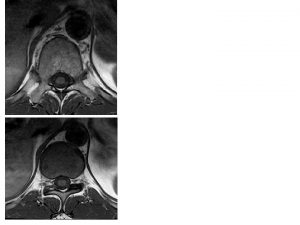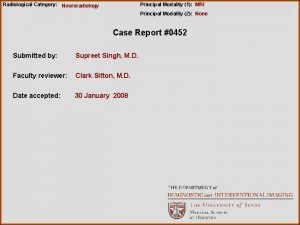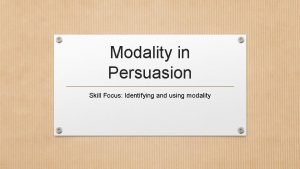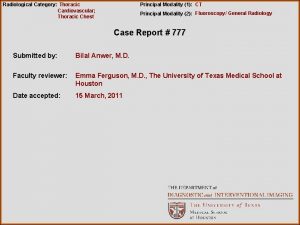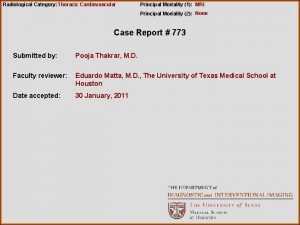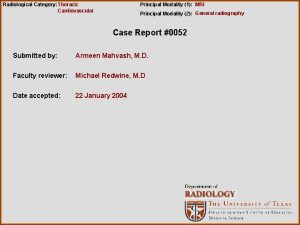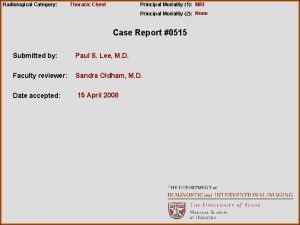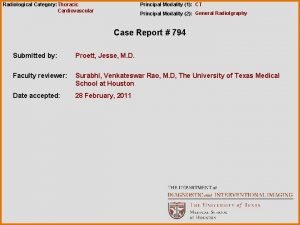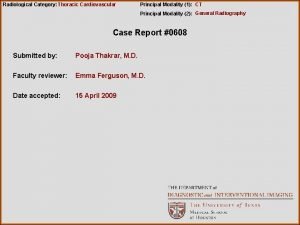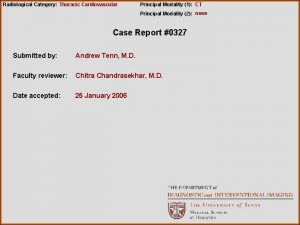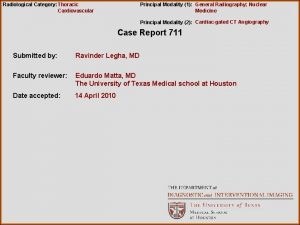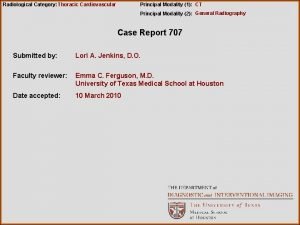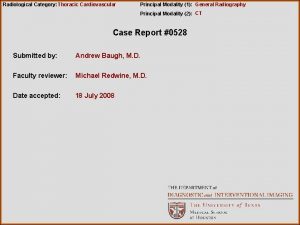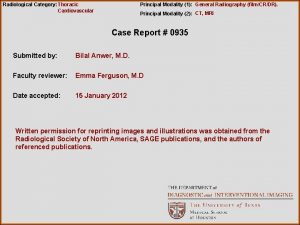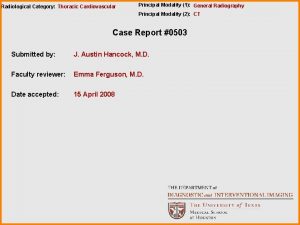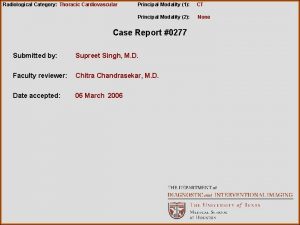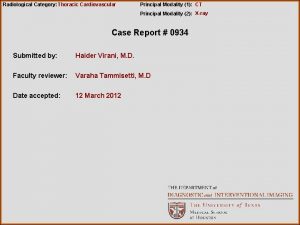Radiological Category Thoracic Cardiovascular Principal Modality 1 MRI















- Slides: 15

Radiological Category: Thoracic Cardiovascular Principal Modality (1): MRI Principal Modality (2): None Case Report #0550 Submitted by: Bhumi Rawal, M. D. Faculty reviewer: Larry Kramer, M. D. Date accepted: 15 January 2009

Case History 14 year old asymptomatic male with family history of heart disease.

Radiological Presentations End-diastole phase in short-axis view End-diastole phase in 4 chamber view

Radiological Presentations Echo planar MR images in systole

Test Your Diagnosis Which one of the following is your choice for the appropriate diagnosis? After your selection, go to next page. • Aortic stenosis • Hypertrophic cardiomyopathy • Dilated cardiomyopathy • Extreme physiologic left ventricular hypertrophy

Findings and Differentials Findings: There is asymmetric hypertrophy of the left ventricular myocardium, especially the lateral wall and the basal interventricular anterior septal wall near the left ventricular outflow tract, causing subvalvular aortic stenosis. There is anterior bowing of the anterior leaflet of the mitral valve due to the venturi effect through the left ventricular outflow tract secondary to high velocity flow at systole. There is no ventricular dilatation. Obtained quantitative data included increased flow velocity along the left ventricular outflow tract (maximum velocity 280 cm/s) and ejection fraction of 81. 8%. Differentials: • Hypertrophic cardiomyopathy • Aortic stenosis with compensatory left ventricular hypertrophy • Hypertensive heart disease • Extreme physiologic left ventricular hypertrophy (athlete’s heart)

Discussion Focal narrowing of the left ventricular outflow tract by asymmetric thickening of the basal septal wall (green marker). Low signal through the outflow tract at systole represents flow turbulence (yellow arrow) due to high velocities. There is bowing of the anterior mitral valve (red arrow) due to the venturi effect.

Discussion In this case, there is not aortic stenosis but subaortic stenosis caused by asymmetric left ventricular basal septal wall hypertrophy. Hypertensive disease can cause concentric left ventricular hypertrophy and is typically seen in older patients with hypertension. In extreme physiologic left ventricular hypertrophy, the maximum left ventricular wall thickness is usually 15 -16 mm and there is consistently an enlarged left ventricular cavity size, making it the incorrect diagnosis in this case. The findings in this case are suspicious for hypertrophic cardiomyopathy.

Discussion Hypertrophic cardiomyopathy (HCM) is hypertrophy of a nondilated left ventricle in the absence of cardiac or systemic disease that could produce the magnitude of hypertrophy present. It is the most common genetic cardiovascular disease, with a prevalence of 0. 2% in the adult population. HCM is caused by a variety of gene mutations encoding sarcomeric proteins. Muscle cell disorganization is present histologically. A variety of names have been used for this process including hypertrophic obstructive cardiomyopathy and idiopathic hypertrophic subaortic stenosis. However, hypertrophic cardiomyopathy is the preferred name because it describes the overall disease spectrum without inferring that left ventricular outflow tract obstruction is present. In fact, HCM is predominately nonobstructive—in 75% patients. HCM is inherited autosomal dominant. However, not all individuals with a genetic defect will have clinical expression of HCM. Also, HCM can clinically present during any phase of life.

Discussion Pathophysiologic findings in HCM include left ventricular hypertrophy that leads to subaortic stenosis, abnormal diastolic function, and myocardial ischemia. Most HCM patients have little or no disability and normal life expectancy. However, some patients have progressive heart failure, atrial fibrillation with embolic stroke, and sudden death. Overall, annual mortality rate is ~1%. HCM is the most common cause of sudden death in the young, including athletes. Sudden death can be the initial manifestation of HCM and occurs most commonly during mild exertion or sedentary activities but is also frequently seen with vigorous physical exertion. Subtypes of hypertrophic cardiomyopathy: • Asymmetric septal hypertrophy—disproportionate thickening of the basal septum of the left ventricle; most frequently occurring subtype • Apical hypertrophy—marked thickening of the apical portion; more prevalent in the Japanese and Korean; usually clinically benign • Symmetric hypertrophy, in 2 -20%

Discussion 2 -D echocardiography has been widely used as a screening tool and as the “gold standard” noninvasive diagnostic tool for HCM. Features of HCM on Echo include (These are not all necessary for a diagnosis of HCM): – Interventricular septal hypertrophy (>12 -15 mm thickness in end-diastole phase) • The degree of left ventricle wall thickness has prognostic significance, showing a direct relationship to the risk of sudden death. With wall thickness ≥ 30 mm, there is highest risk of sudden death. – Abnormal ratio of thickness of the septum to the left ventricular posterior wall – Systolic anterior motion of the mitral valve, inducing obstruction of the left ventricular outflow tract and mitral regurgitation • This systolic motion of the mitral valve is thought to be induced by the venturi effect of rapid flow through the narrow LV outflow tract. – Narrowing of the left ventricular outflow tract during systole – High velocity across the left ventricular outflow tract – Midsystolic closure of the aortic valve – Normal or hyperkinetic left ventricular function

Discussion These features can also be demonstrated by cardiac MRI. Cardiac MRI does have some advantages over echocardiography and may enable diagnosis of HCM in those cases where echocardiography fails. Advantages of cardiac MRI include: – Large field of view – Higher resolution, allowing evaluation of small areas of involvement – Clear depiction of natural contrast between the blood and cardiovascular structure, allowing accurate evaluation of myocardial thickness and location and severity of the abnormality – Excellent soft tissue characterization – Good capability of creating images with direct multiple planes

Discussion Treatment plan varies depending on subtype and symptoms: – Exertional dyspnea and progressive heart failure symptoms—drug therapy – Severe refractory symptoms associated with marked outflow obstruction— septal myotomy-myectomy operation with alcohol septal ablation and pacing being alternatives to surgery – Atrial fibrillation—pharmacological rate control, cardioversion, and anticoagulation – High-risk patients, for sudden death prevention—implantable cardioverterdefibrillator

Diagnosis Hypertrophic cardiomyopathy with asymmetric left ventricular hypertrophy and evidence of narrowing and hemodynamic effects on the left ventricular outflow tract

References Brant WE, Helms CA. Fundamentals of Diagnostic Radiology, 2 nd ed. Baltimore, MD: Lippincott, 1999: 556 Maron BJ. Hypertrophic Cardiomyopathy: A Systematic Review. JAMA 2002; 287: 13081320 Park JH, Kim YM, Chung JW, Park YB, Han JK, Han MC. MR Imaging of Hypertrophic Cardiomyopathy. Radiology 1992; 185: 441 -446 Pelliccia A, Di Paola FM, De Luca R. Athlete’s Heart and Cardiomyopathy. http: //pcvc. sminter. com. ar/cvirtual/cvirteng/cienteng/cem 3901 i/ipellicc. ht m Rickers C, Wilke NM, Jerosch-Herold M, et al. Utility of Cardiac Magnetic Resonance Imaging in the Diagnosis of Hypertrophic Cardiomyopathy. Circulation 2005; 112: 855861
 Corpus callosum anatomy radiology
Corpus callosum anatomy radiology Pa erate
Pa erate Radiological dispersal device
Radiological dispersal device Tennessee division of radiological health
Tennessee division of radiological health Center for devices and radiological health
Center for devices and radiological health National radiological emergency preparedness conference
National radiological emergency preparedness conference Mri principal
Mri principal Lexical vs auxiliary verbs
Lexical vs auxiliary verbs High modality definition
High modality definition Epistemic modality
Epistemic modality Short wave diathermy definition
Short wave diathermy definition Tom arbuthnot
Tom arbuthnot Modality in statistics
Modality in statistics Sodality vs modality
Sodality vs modality Cardinality and modality
Cardinality and modality Deontic and epistemic modality exercises
Deontic and epistemic modality exercises
